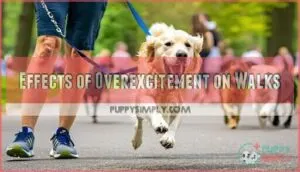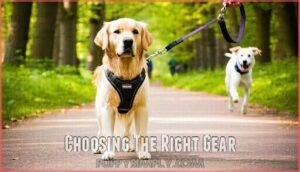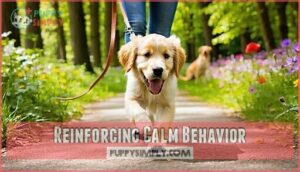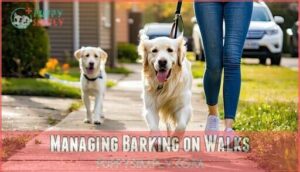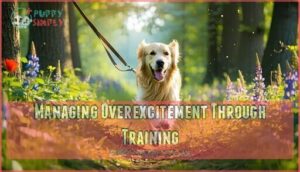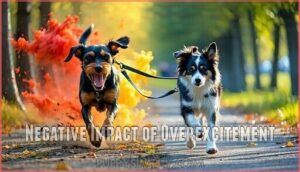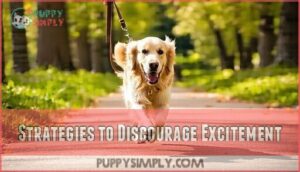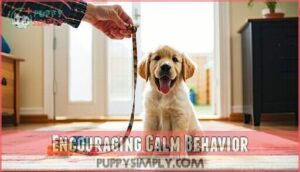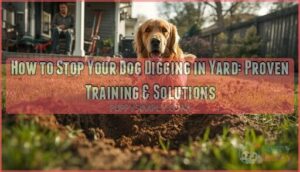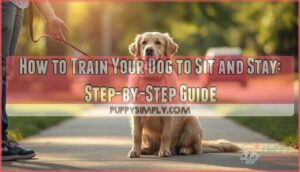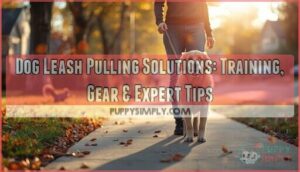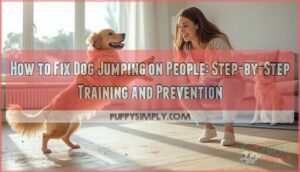This site is supported by our readers. We may earn a commission, at no cost to you, if you purchase through links.
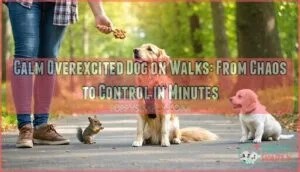
Choose a front-clip harness or head collar for better control than traditional collars. When excitement peaks, stop walking immediately and wait for calm behavior before continuing.
Use high-value treats to reward relaxed walking and redirect attention from triggers like other dogs or squirrels. Keep initial walks short and gradually increase duration as your dog learns self-control.
The secret lies in consistency and timing—rewarding the right moments transforms chaotic walks into peaceful strolls faster than you’d expect, which is the key to achieving peaceful strolls.
Table Of Contents
- Key Takeaways
- Understanding Overexcitement
- Effects of Overexcitement on Walks
- Leash Training and Impulse Control
- Managing Overexcitement Through Training
- Why Dogs Become Overexcited
- Negative Impact of Overexcitement
- Strategies to Discourage Excitement
- Encouraging Calm Behavior
- Physical and Mental Outlet for Dogs
- Effective Products for Calming Overexcited Dogs
- Frequently Asked Questions (FAQs)
- How to calm a hyper dog on walks?
- Why does my dog get overly excited on walks?
- What is the 123 method for dogs?
- How do I get my dog to stop being overly excited?
- Can weather conditions affect dog walk excitement?
- How does dog age impact overexcitement levels?
- Should I use medication for reactive dogs?
- What role does diet play in excitement?
- How do I handle multiple overexcited dogs?
- Conclusion
Key Takeaways
- Start training before you leave – Practice "wait" commands at your door and do not attach the leash until your dog sits calmly, setting the tone for controlled behavior from the beginning.
- Use proper equipment for better control – Choose front-clip harnesses or head collars instead of traditional collars, as they reduce pulling by 50% and give you immediate leverage over excited behavior.
- Stop and wait when excitement peaks – The moment your dog gets overexcited, stop walking completely and wait for calm behavior before continuing – consistency with this timing transforms chaotic walks faster than you would expect.
- Reward calmness with high-value treats – Carry special treats to immediately reward relaxed walking and redirect attention from triggers like other dogs or squirrels, building positive associations with controlled energy.
Understanding Overexcitement
Your dog’s brain lights up like a pinball machine when excitement hits.
When excitement strikes, your dog’s mind becomes a chaos storm of pure energy.
Dopamine floods their system, triggering hunting instincts that once helped wild ancestors survive.
This arousal addiction creates a cycle where your overexcited dog craves more stimulation during walks.
Common excitement triggers include other dogs, squirrels, or even the leash itself.
The alarm response releases adrenaline, preparing them for action.
Understanding this neurochemical cocktail is key to effective dog walk training and developing better dog behavior through targeted dog training tips for calm dog walks.
Effects of Overexcitement on Walks
When your overexcited dog hits the pavement, chaos often follows.
Walk frustration builds as your pup lunges at every passerby, turning peaceful strolls into wrestling matches.
These Reactive Incidents create Safety Concerns for everyone involved, potentially causing injuries or scaring other walkers.
Over time, you’ll face Social Isolation as neighbors avoid your unpredictable duo.
Training setbacks multiply when your overexcited dog practices poor leash manners repeatedly, reinforcing bad habits.
Dog reactivity becomes a cycle where each chaotic walk strengthens unwanted behaviors.
Without proper dog walk training, your dog’s excitement transforms simple outings into exhausting ordeals that strain your relationship and community connections.
Recognizing potential triggers can help prevent escalation, as fear can cause aggression, and addressing these issues is crucial for a harmonious dog walk training experience.
Leash Training and Impulse Control
You’ll transform your overexcited pup into a calm walking companion with the right combination of proper equipment and consistent training techniques.
Teaching impulse control isn’t just about stopping the pulling—it’s about creating a mindset where your dog looks to you for guidance instead of reacting to every squirrel, jogger, or friendly face they encounter, which requires consistent training.
Choosing The Right Gear
Your gear can make or break your walks.
Front-clip harnesses reduce pulling by 50% compared to collars, while head halters like the Gentle Leader offer superior control.
Consider a harness for walking your dog.
Choose 6-foot leashes for ideal balance between freedom and safety.
Don’t forget your treat pouch and clicker training gear – they’re game-changers for teaching leash manners on the go.
Reinforcing Calm Behavior
When training transforms frustration into success, you’ll discover that consistent reinforcement creates lasting change.
Reward calmness immediately when your dog shows calm behavior during walks, using high-value dog training treats to build positive association with controlled energy.
Here’s your roadmap to consistent reinforcement:
- Use calming cues – Practice "easy" or "settle" commands before excitement peaks
- Reward immediately – Timing matters more than treat size for positive reinforcement
- Stay consistent – Dog training consistency means rewarding calm behavior every single time
- Practice gradual exposure – Start in quiet areas, then slowly increase distractions
This approach helps calm dog on walks naturally.
You can also use positive reinforcement methods to further encourage calmness.
Release & Permission Before Dog Greetings
Teaching your dog to wait for permission transforms chaotic encounters into controlled greetings.
Before allowing any dog interaction, establish clear greeting protocols that emphasize consent importance.
Your dog must sit and make eye contact with you first.
| Step | Action |
|---|---|
| Approach | Stop 10 feet away from other dog |
| Position | Command "sit" and wait for compliance |
| Assessment | Read both dogs’ body language for stress |
| Permission | Give "okay" only when both dogs are calm |
| Monitor | Watch for signs of overarousal during greeting |
This controlled approach prevents leash reactivity by managing dog triggers before they escalate.
Safe interactions depend on recognizing dog communication signals and maintaining controlled approaches throughout the encounter.
Managing Barking on Walks
Now your dog’s greeting manners are under control, but what about that incessant barking that turns every walk into a neighborhood concert? Dog barking often stems from specific triggers like other dogs, strangers, or exciting distractions during walks.
Start by teaching quiet commands at home when your pup’s calm. Use "enough" or "quiet" consistently, rewarding silence immediately.
During walks, identify your dog’s triggers and practice redirecting focus before they escalate. When barking starts, stop walking and wait for quiet before continuing.
Consistent training with leash reactivity requires patience, but distance from dog distractions helps. Remember, your calm energy influences theirs—staying composed while implementing barking solutions makes all the difference in successful dog training.
Managing Overexcitement Through Training
Training techniques can transform your overexcited walker into a calm companion within weeks. You’ll learn proven methods that address the root causes of reactive behavior, not just the symptoms.
Detox Training for Leash Reactivity
Picture your walks transforming from battlegrounds to peaceful strolls—that’s detox training’s power.
You’ll completely avoid triggers during the initial weeks, creating a clean slate for your overexcited dog’s behavior patterns.
Here’s your detox training roadmap:
- Trigger Avoidance: Skip busy parks and crowded streets for 2-3 weeks
- Controlled Exposure: Gradually reintroduce stimuli at safe distances once calm walking tips show progress
- Setbacks Management: Don’t panic if your dog regresses—it’s normal during the reintroduction process
This approach stops dog pulling by resetting expectations.
Your loose leash walking goals become achievable when you give leash reactivity time to fade naturally.
Engaging The Dog’s Nose
Your overexcited dog’s nose holds the key to instant calm.
Scent work benefits include reduced anxiety and improved focus during walks. Try these simple nosework training games to transform chaotic outings into peaceful strolls.
Consider enrichment through foraging to keep your dog mentally stimulated.
| Activity | How It Helps |
|---|---|
| Sniffing walk alternatives | Allows natural foraging behavior |
| Tracking for calmness | Engages hunting instincts positively |
| Foraging toy options | Provides mental stimulation pre-walk |
| Kibble searches | Increases focus, decreases excitability |
Calming Techniques for Dog Owners
Your dog’s overexcitement often mirrors your own Owner Energy – stay calm and watch the magic happen.
When you maintain Consistent Rules and use a Calm Voice, you’re teaching powerful calming techniques that transform chaotic walks into peaceful strolls.
- Control your energy: Keep movements slow and deliberate – dogs read your body language like their favorite book.
- Establish an Exercise Routine:** Tire them out before walks to reduce reactive behavior by 40%.
- Practice calm dog exercises: Train focus on walks** using treats for attention instead of pulling.
- Build a Positive Bond: Use dog training techniques that reward relaxation, strengthening your connection through dog training advice** that actually works.
Why Dogs Become Overexcited
When your dog spots a squirrel, their hunting instincts kick in, triggering dopamine release that makes excitement incredibly rewarding.
This anticipation creates dog arousal that’s almost addictive—your overexcited dog craves these thrilling moments.
Alarm triggers like sudden noises activate their predatory drive, flooding them with adrenaline.
Unfortunately, this arousal addiction means your pup actively seeks out exciting situations, turning peaceful walks into chaotic adventures filled with pulling and lunging at every stimulus.
Addressing these issues early can prevent advanced behavioral problems and lead to a more balanced and calm relationship with your dog, avoiding advanced behavioral problems and ensuring a more enjoyable experience for both you and your overexcited dog.
Negative Impact of Overexcitement
Beyond the surface chaos, an overexcited dog creates ripple effects that impact everyone’s well-being.
Your dog’s leash reactivity doesn’t just disrupt walks—it builds dog stress and anxiety that compounds over time.
This heightened state affects dog body language, making social interactions unpredictable and potentially dangerous.
The consequences extend far beyond pulling:
- Increased stress affects both you and your dog, creating a cycle of tension during every outing
- Safety risks emerge when reactive behavior leads to accidents or confrontations with other dogs
- Social isolation develops as you avoid crowded areas, limiting your dog’s healthy socialization opportunities
Health consequences include elevated cortisol levels and damaged relationships with neighbors who witness aggressive displays.
Understanding these impacts helps you recognize why addressing overexcitement isn’t just about better walks—it’s about your dog’s overall quality of life.
Strategies to Discourage Excitement
When overexcitement turns walks into wrestling matches, it’s time to flip the script.
Start with calming cues like "easy" or "settle" practiced at home first. Use dog leash training basics: stop moving when your overexcited dog pulls, rewarding only calm behavior.
Redirect energy through quick direction changes or asking for simple commands. Dog training techniques work best when you stay calm—your energy sets the tone.
Create a safe space mentality by avoiding high-stimulus areas initially. Dog impulse control improves with consistent quiet walks during off-peak hours.
Even lick mats before walks help establish relaxation patterns.
Encouraging Calm Behavior
While discouraging excitement helps control reactivity, building calm behavior creates lasting change.
Your overexcited dog needs positive reinforcement when they display relaxed responses.
Start with calming cues like "settle" or "easy" during pre-walk routines.
Practice these commands in your living room first, then gradually move closer to the door.
Create a safe space where your dog can decompress before walks.
Mental stimulation through puzzle toys or "find it" games helps tire their brain, making leash training more effective.
When your dog sits calmly before the leash goes on, immediately reward them with treats and praise.
Reinforce relaxation by rewarding quiet moments during walks.
If your dog notices a trigger but doesn’t react, that’s your golden opportunity to use positive reinforcement.
These dog training techniques build confidence and teach your pup that staying calm pays off better than losing their mind.
Physical and Mental Outlet for Dogs
Why do some dogs turn into furry tornadoes the moment they step outside? Your overexcited dog needs proper outlets to channel that boundless energy into calm behavior.
Exercise Benefits are clear: regular physical activity reduces hyperactivity by up to 60%. Daily walks of at least 30 minutes help expend excess energy that would otherwise fuel chaotic behavior. But here’s the thing—your dog’s Breed Needs matter. A Border Collie requires more intensive exercise than a Bulldog.
Mental Stimulation works like a magic reset button. Puzzle Toys during dog walks engage their problem-solving skills, reducing anxiety by 40%. Try treat-dispensing balls or hide kibble in grass for them to find. These Training Games transform walks from chaos into focused adventures.
Interactive activities like fetch or simple agility exercises provide both physical and mental challenges. Even "sniff walks"—allowing 15 minutes of unstructured exploration—satisfy their natural instincts while promoting focus. When you combine physical exercise with mental engagement, you’re giving your overexcited dog exactly what they need to develop self-control.
Effective Products for Calming Overexcited Dogs
Transform chaotic walks into peaceful strolls with the right calming products for your overexcited dog.
Smart walking gear like a front-clip harness or gentle leader provides immediate control, while calming treats and pheromone products address underlying anxiety.
The demand is fueled by rising awareness of pet anxiety.
- Training Gear: Head halti and puzzle toys redirect energy during walks
- Calming Aids: Lick mats and prescription medication offer long-term behavioral support
These tools work together to create manageable, enjoyable walks for both you and your furry companion.
Frequently Asked Questions (FAQs)
How to calm a hyper dog on walks?
Use front-clip harnesses and practice standing still when your dog pulls. Redirect with smooth u-turns, carry high-value treats, and stay calm yourself—your energy directly influences theirs.
Why does my dog get overly excited on walks?
Roughly 60% of dogs show overexcitement during walks because their brains release dopamine from anticipation, activating hunting instincts.
Your dog’s excitement stems from triggers like other dogs, interesting smells, or simply the thrill of exploration—it’s natural behavior.
What is the 123 method for dogs?
The 123 method involves counting ‘one, two, three’ out loud and giving a treat on ‘three’ to build focus and anticipation.
Then, taking 3 steps while counting and rewarding on the third step during walks.
How do I get my dog to stop being overly excited?
Start with consistent training and patience.
Redirect your dog’s energy using calm commands, high-value treats, and proper exercise before walks.
Practice impulse control daily, avoid reinforcing excited behavior, and maintain your own calm energy throughout.
Can weather conditions affect dog walk excitement?
Weather absolutely affects your dog’s excitement levels during walks. Cold temperatures can make dogs more energetic and playful, while hot weather might increase irritability or stress-related reactions to triggers.
How does dog age impact overexcitement levels?
You can’t teach an old dog new tricks, but age definitely affects excitement levels.
Puppies are bundles of energy with poor impulse control, while senior dogs typically mellow out.
Young dogs need more training patience than their calmer, wiser counterparts, and this is where patience is key to their development.
Should I use medication for reactive dogs?
Medication can help reactive dogs when behavioral training isn’t enough. You’ll want to consult your vet first – they might recommend anti-anxiety meds alongside training for best results.
What role does diet play in excitement?
Diet plays a vital role in your dog’s excitement levels.
High-sugar foods and artificial additives can spike energy, while protein-rich meals provide sustained fuel for hyperactivity.
Consider switching to calmer-promoting ingredients.
How do I handle multiple overexcited dogs?
Managing multiple overexcited dogs requires patience and strategy.
Train them separately first, then together.
Use individual leashes, maintain calm energy, and reward quiet behavior.
Keep sessions short—chaos becomes manageable when you divide and conquer systematically.
Conclusion
Ready to transform your daily walks from wrestling matches to peaceful strolls? The journey to calm overexcited dog on walks requires patience, but the payoff is immediate.
Start with proper gear, practice consistent commands, and reward calm behavior every time. Remember, your dog feeds off your energy—stay relaxed and confident.
With these proven strategies, you’ll notice dramatic improvements within days. Every walk becomes an opportunity to strengthen your bond while enjoying the simple pleasure of a well-behaved companion by your side.
- https://www.pawleaks.com/puppy-socialization-how-to-socialize-your-puppy/
- https://www.thekin.com/behavior?&utm_source=referral&utm_medium=wildest&utm_campaign=article_upsell_behavior
- https://www.whole-dog-journal.com/behavior/training-a-hyperactive-dog-to-calm-down/
- https://www.nature.com/articles/s41598-022-26991-5
- https://cvets.net/5-ways-to-calm-an-overly-excited-dog/

